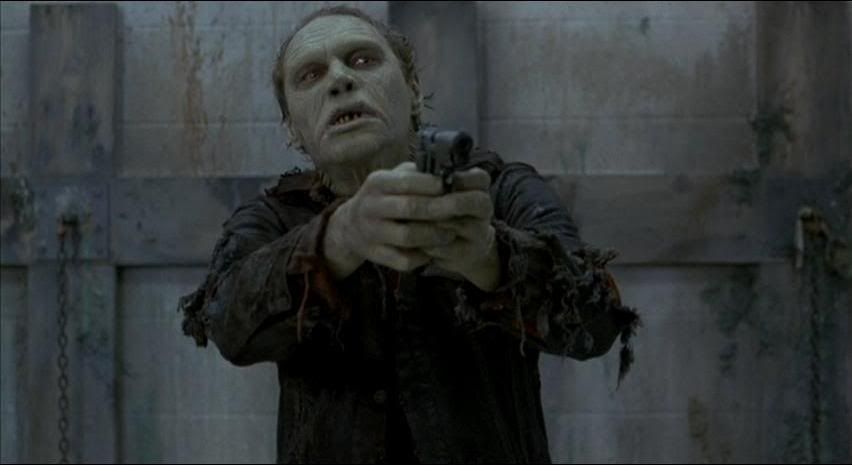 If ‘Night of the Living Dead’ and ‘Dawn of the Dead’ share the same idea of a place of sanctuary as a prison for the self, their protagonists facing up as much to their own demons as to the horde of zombies massing outside, then the milieu of ‘Day of the Dead’ (1985) is even more claustrophobic.
If ‘Night of the Living Dead’ and ‘Dawn of the Dead’ share the same idea of a place of sanctuary as a prison for the self, their protagonists facing up as much to their own demons as to the horde of zombies massing outside, then the milieu of ‘Day of the Dead’ (1985) is even more claustrophobic.The opening sequence is the only glimpse of daylight, of the outside world, that we get. A helicopter touches down in a deserted Florida township. An alligator crawls out of the First National Bank. Dollar bills blow uselessly along the street. Before the zombies even appear, we’re back in familiar Romero territory: a recognisable America, but one where all the tenets of societal familiarity are but empty symbols.
The helicopter crew, including pilot John (Terry Alexander) and research assistant Sarah (Lori Cardille), discover no survivors or supplies, and return to the underground facility that is their base. Ostensibly a scientific outpost where Dr Logan (Richard Liberty) is conducting neurological research on captured zombies, the medicos are outnumbered by a military contingent. The two factions are at loggerheads from the off, the military proving to be the macho, racist backwoodsmen of ‘Night’ and the rampaging bikers of ‘Dawn’ revisited - but with uniforms and better weaponry.
Logan, nicknamed Frankenstein by the soldiers, is attempting to condition the zombies, to return them to their erstwhile capacity for civilised behaviour. One zombie in particular, whom Logan calls Bub (after his father!), shows signs of human behaviour: he recognises a soldier’s uniform and salutes him; he strips down and reassembles an unloaded pistol; he leafs through a Stephen King novel; and - in a witty homage to ‘A Clockwork Orange’, listens to Beethoven’s 9th.
It’s when the military discover Logan’s secret - he is rewarding Bub by feeding him human flesh - that all hell breaks loose. Logan is killed and John severely beaten, his ability to fly a helicopter the only thing that saves him from an equally summary execution. In the meantime, the dead - as in the previous films - have amassed outside. Even as the military try to escape the compound, the dead flood in. The last twenty minutes of the film comprise Romero’s goriest work, an almost constant stream of dismemberment, beheadings and disembowelment.
After the satire of ‘Dawn’, this is a return to the nihilism of the first film. The military, far from containing the problem, just contribute to it. Science also fails - Logan’s almost-breakthrough comes at the sacrifice of his humanity and the cost of his life. Finally, it one of the helicopter crew, embittered against his colleagues, bullied by the soldiers, who suicidally gives the zombies their way in.
Even the seemingly redemptive ending, where the handful of survivors make it out by helicopter and fetch up on an idyllic and zombie-free island, is overshadowed. The zombies, in defeating the military, have begun to arm themselves, to use weapons. How long, Romero is asking, until they fully organise themselves? It is this question that he debates in ‘Land of the Dead’.







































No comments:
Post a Comment